On July 25, 2020, an unprecedented maritime disaster occurred on the Southeast coast of Mauritius, sparing no village located on the coast. Faced with the inaction and indecision of the country’s leaders, a huge movement has developed in the country. Thousands of people from all over the country had gathered in Mahebourg to help stop the spread of the oil spill. An action bringing together ordinary citizens, ecologists, those who are politically engaged, men, women but also the youth. These people were trying somehow to make homemade buoys to curb the tons of heavy oil that threatens to reach the coast and fragile ecological zones. This shipwreck has been approached in several ways; however, it is important to underline the role that women have led in this action. To address this subject, the Ki nouvo Moris platform invited two women who were at the forefront of this fight, Yolanda Hennequin and Natasha Magraja both committed citizens and members of the Rezistans ek Alternativ (ReA).
Where is it 3 years after the sinking?
Yolande Hennequin stated the debate by saying that 3 years later, the pain is just as intense. She qualifies this suffering as something that people will carry with them for a long time. The activist claims that despite this maritime disaster, she keeps hope in the Mauritian citizens because the solidarity she has witnessed gives hope for a new Mauritius. Indeed, it is this motivation, the mutual aid that emerged during this black tide that will remain engraved in the heart of everyone. Natasha Magraja joins her comrade by emphasizing that a trust has been built and that if ever another ecological massacre occurs, the Mauritian people will once again in motion.
Why did women mobilize and stayed several days on the waterfront?
There are several reasons why women have taken action. They braved the cold nights and spent whole days helping to make buoys just out of love for the sea, claims Yolande Hennequin.
“It is the love for nature that has created this momentum of Mauritianism bringing together all social strata but especially women. Indeed, the people who live on the coast have a very strong link with the sea and it is precisely this link that has made this setting in motion possible.”
Natasha Magraja for instance thinks that women are more sensitive to this shipwreck because they see the sea as a mother who helps them to daily feed themselves, resource themselves and who helps their children to flourish. In addition to the fact that they used to exploit the sea by fishing and collecting sea-foods. As a result, women were ahead for the construction of the buoys, and they contributed their know-how by explaining how to sew the nets to save time and also make them more efficient.
How did the shipwreck affect the lives of people living on the southeast coast?
The life of people living on the coast has been greatly affected because the majority have lost their jobs because many of them had a job related to the sea. The fisherman, those who collect shells to sell them have unfortunately stopped their economic activities because the fish and the seafood were inedible due to the large amount of heavy oil that accumulated in the lagoon. Some have been able to reorient themselves in another economic sector and unfortunately others have not been able to do so since the Covid-19 was also in full swing.
During these last 3 years, many people are struggling to make ends meet despite the fact that the economic activities linked to the sea are operational again, the sinking has left a big psychological but also economic sequel since many people who worked in sea related activities have not been compensated for the damage suffered.
Yolande Hennequin continues the debate by saying that the shipwreck has accentuate the misery within several families. Before, when the sea was not polluted by heavy oil, several women, in order to be able to meet the needs of their children or to be able to make ends meet, would go fishing. However, this is no longer the case today because restaurateurs no longer buy seafood with them for fear of the side effects that the consumption of their products may create later.
Single mothers are the most affected because previously they earn more than a minimum wage with this economic activity except now some live with 3500 to 5000 rupees per month which plunges them into a precarious situation. With the child who have to be sent to school, the bills to pay and the ever-increasing food basket, those who were affected by the sinking to the MV Wakashio are struggling to get by on a daily basis.
What advice for women?
Yolande Hennequin and Natasha Magraja ask women not to be afraid anymore and to let their voices be heard because they have a lot to say. Both activists find it unfortunate that society wants to muzzle women every time she dares to denounce the injustice, she suffers every day. They strongly encourage women to get in motion and join political movements because change does not happen alone. In order to have the systemic changes that people keep asking for, everyone will have to invest in a healthy policy that takes into consideration the welfare of the working class and women.
Watch the debate here:


